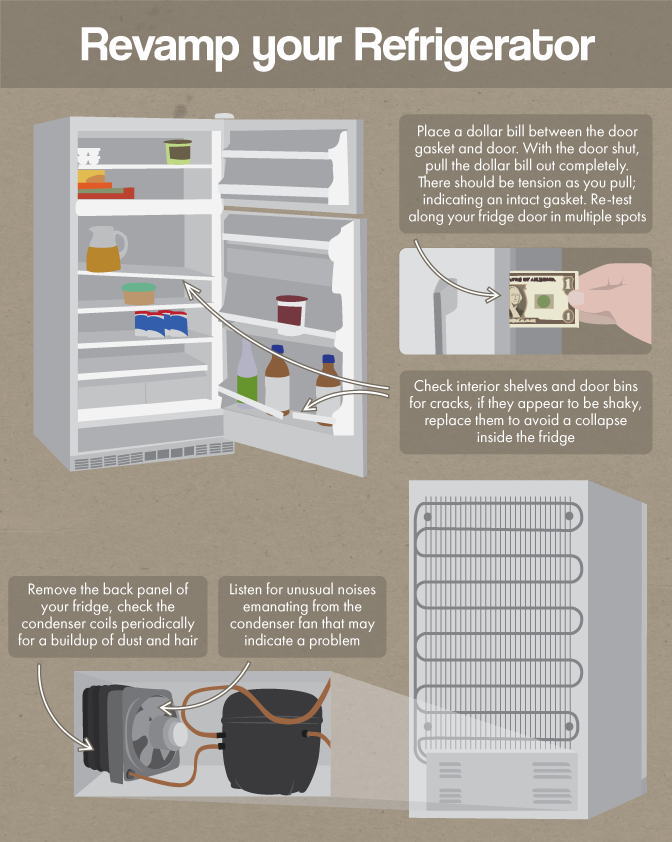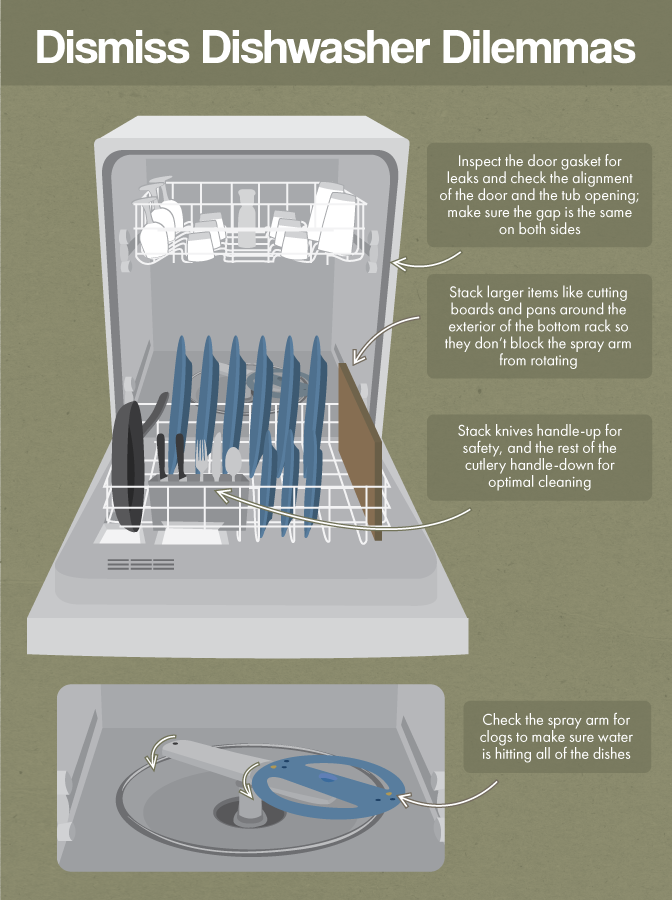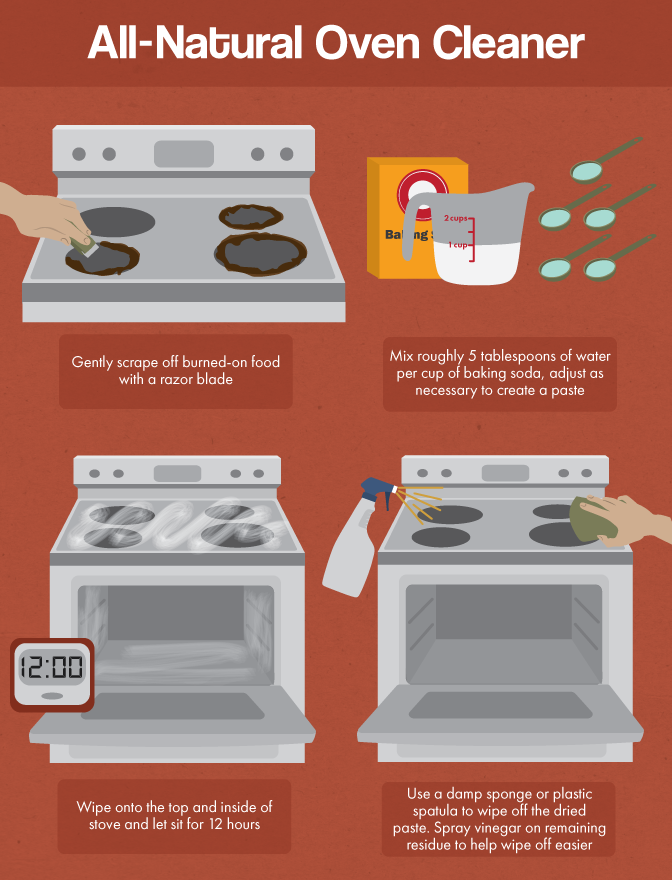Home Appliance Maintenance
A Little Minor Upkeep Can Prevent a Major Catastrophe
So you’ve just moved into your new home and are experiencing pride in ownership for the first time.
This means many things: mowing the lawn, de-mucking the gutters, but most importantly cleaning your kitchen appliances more often than the day you vacate your apartment!
Now when your dishwasher breaks down, it’s no longer good enough to simply call the landlord and wait for them to fix the problem for you.
You may be confronted with a range of complicated and frankly scary-looking appliance parts for the first time. But keeping everything running smoothly is not as daunting as it seems.
Perhaps you’re a long-time homeowner, hearing strange noises from your dishwasher or experiencing a warm fridge for the first time.
Whatever your situation, these easy maintenance tips consist mostly of keeping your appliances clean, with a little light troubleshooting thrown in to nip problems in the bud.
Instead of shelling out $1,000 for a new kitchen appliance, invest in keeping the ones you have in tip-top shape.
Refrigerator
The refrigerator is the Energizer Bunny of appliances – it never stops working. It would be an inconvenience to have your washer or dryer malfunction and interrupt your weekly wash cycle, but the refrigerator has much higher stakes.
Keeping your fridge in good working order is crucial to avoid a breakdown that could cost you all of your chilled food. Avoid having a “going out of business” feast by following these regular fridge maintenance tips.
Maintain your refrigerator’s gaskets. The vinyl strip that forms a seal between the cabinet and the doors will keep the appliance running efficiently and help extend its life.
Damaged door gaskets can allow room-temperature air to enter the refrigerator cabinet and create excess moisture and frost issues that could prevent your refrigerator from cooling properly.
Any tearing or loosening means you have to replace your door gasket, and this can be one of the most tricky appliance parts to swap out.
You can extend the life of your gaskets by applying a vinyl conditioner or a thin film of petroleum jelly to help them stay pliable and to form a better seal. (Also, wipe up any spills before they stick to the gaskets and you won’t have to replace them.)
Proper airflow through the condenser is essential for the efficient and long-lasting performance of your refrigerator.
Household dust and pet hair that accumulate on condenser coils or condenser fans can restrict airflow, which could result in overheating and failure of the compressor or associated sealed system components.
These repairs can be expensive and often end with the refrigerator being scrapped.
Remove the back panel of the refrigerator and clean the coils with a handheld vacuum and a soft brush. There may also be condenser coils below the bottom compartment of your refrigerator. Make sure the condenser fan is clean and functions properly, too.
Make sure that the hinge components of your refrigerator are in good shape and are properly lubricated. The doors on your refrigerator get opened a lot and some wear on these components is to be expected.
Check the top hinges for wear and adequate lubrication. Bottom hinges also need to be inspected periodically for damage or lack of lubrication. Always use a food-grade lubricant on kitchen appliances.
Replace any broken or cracked door bins, shelf end caps, or retainer bars as soon as the defect is noted so as not to cause any further damage.
Glass shelves, crisper drawers, and drawer slides should also be replaced as soon as any defect is apparent.
Listen for any unusual sounds that may emanate from the condenser fan or evaporator fan motors, such as rattling, squeaking, squealing, or buzzing.
These may be a sign of an impending failure and should be addressed as soon as possible, before the cooling system stops working.

Dishwasher
This labor-saving appliance would be sorely missed if it did not function properly. The main thing to keep in mind with your dishwasher is that what you consider to be normal usage can be damaging over time.
Properly loading the dishwasher and giving it regular maintenance checks will help to make sure a problem doesn’t develop right under your nose.
Review the following checklist to ensure you are not up to your elbows in dirty dishes when you could be doing something more enjoyable.
Inspect the door gasket or seal on your dishwasher for damage or defects and replace it if necessary. A leaking door seal can be frustrating and also cause expensive damage to your floor. Regularly clean it with soap and water to keep a watertight seal.
Load your dishwasher carefully so as not to damage the racks. They are typically constructed of steel wire and coated with a vinyl material that can be damaged with rough use.
Dishware that has sharp edges can cut through the vinyl coating and expose the metal wire, causing it to rust. Vinyl repair kits are readily available: recoat any affected areas before they become too rusted.
Both lower and upper racks normally have wheels or rollers that are easily replaceable as well.
Dishwasher racks are easy to replace but are often expensive, so keeping them in good shape can save you money and prevent one more appliance from ending up in a landfill.
Check the operation of the detergent and rinse aid dispenser. Make sure that the detergent dispenser door latches tightly but opens during the wash cycle.
Keep the rinse aid dispenser full and ensure that the cover fits tightly. Look for any signs of a water leak in the area of the dispenser as well. These parts are easy to replace: accessing them usually just involves removing the inner door panel.
When your dishwasher is running, listen for unusual sounds like grinding, rattling, or scraping noises. Foreign debris such as broken glass or bone fragments that enter the pump area can cause serious damage to impellers, seals, and filters.
At the first sign of any unusual sounds you should discontinue using the dishwasher and have the symptom checked out.

Oven and Range
You may not need your range to survive, but it constitutes the heart of your home. Without it, you’re left eating an endless array of microwaved meals and cereal. The key to keeping this asset in good working order comes down to cleaning up after each use.
The main cause of damage to your range and stove is caked-on food that is left to re-burn over and over again after each use. Head these issues off at the pass by following these tips to keep your range and oven clean.
Wash up any spills as soon as they happen to prevent them from becoming baked on and harder to remove.
If your range or cook top has drip bowls or trim rings, they should be cleaned regularly with a grease-dissolving cleaner. Baked-on stains may require soaking in a solution of baking soda and water or vinegar.
When removing the drip bowls, check the surface element terminals for any signs of arcing or corrosion. Replace the terminal block or receptacle for any defective burner you find.
For spills on smooth-top ranges, allow the surface to cool and then scrape with a razorblade if necessary before using an approved cleaner for glass-ceramic surfaces.
Clean your oven before the food soil damages the liner surface.
Spills from baking often contain sugars that are acidic and can cause damage to the oven liner if left too long. Remember to remove oven racks when using a self-cleaning cycle, as they cannot tolerate the high temperature.
Keep the oven door gasket clean. Food spills will harden the gasket and could allow heat to escape. If the seal is damaged it can be replaced easily.
To avoid a disaster during a holiday dinner or special occasion, make sure you replace any defective burners, oven elements, infinite heat controls, or other stove parts when the problem first occurs.

Now you’re armed with the knowledge you need to keep your kitchen running. The upside of running into small problems with your appliances is that once you find out how easy it can be to fix them, you’ll no longer be intimidated by these handyman tasks.
You may even start to go looking for problems you can fix in every room in your home!
Embed the article on your site

